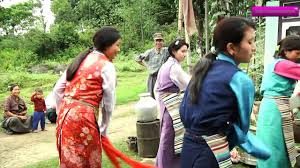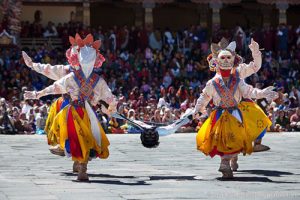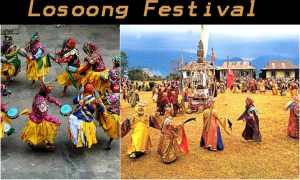Folk Songs of Sikkim
People and Culture of Sikkim
- The People of Sikkim consist of three ethnic groups, that is, Lepcha, Bhutia and Nepali.
- Communities of different hues intermingle freely in Sikkim to constitute a homogenous blend.
- Hindu Temples coexist with Buddhist Monasteries, Churches, Mosque and Gurudwara.
- The predominant Communities are Lepchas, Bhutias and Nepalese.

- These myriad Cultures has produced a quintessential Sikkimese Culture that encompasses all ways and walk of life, but has also managed to preserve their own identity.
- These can also be seen in the various places of Worship, Festivals and Cultural dances that are celebrated through the year.
- Folk songs and folk dances occupy a prominent place in the culture of Sikkim.
- Men and womenfolk fully participate in dances to mark such important occasion like birth, weddings rituals or any other festivals
- For those belonging to the peasant & labour class the melodious folk songs and dances arc indeed life giving ambrosia whose lifting tones & rhythmic pattern wipes away their fatigue hunger & worries.
Music cum Dance of Bhutias of Sikkim
- Bhutias have a rich folk culture. Men and women sing folk songs and perform folk dances.
- ‘Denjong Chha-Lu’ is one of the popular national songs of an older Sikkim, Beyul Demojong – a hidden land endowed not only with natural beauty but also with spiritual contentment.
- Bhutias are devotedly Buddhist and the Denjong Chha-Lu highlights the significance of the secret land of plenty i.e. Sikkim.
- Through this song-cum-dance marked with foot-tapping and graceful hand movements, the Bhutias also express their reverence of great teachers and sacred places by whose grace Sikkim has become a beatific land.
- The dancers don traditional attire (see above) to perform. Musical accompaniment is provided by instruments like the dranyen (a six stringed instrument producing melodious notes), gyumang (many stringed instrument, usually 74-stringed), piwang (two stringed instrument), flute, cymbals and drums. Bhutias are intrinsically nature-lovers.
- Their country songs, called zhunglu, mostly contain descriptions of the landscape and its animals.
- The song, ‘Zigmo Zeepa Jhoen’ means to greet animals and witness their merrymaking.
- With rhythmic foottapping matched by the music of the dranyen, gyumang, piwang, flute, cymbals and drums, the dancers first greet the sun, and then form a circle to greet the snow lion of the mighty mountain, the vulture, the king of the birds, the ten-horned stag of the flat land, the striped tiger of the jungle, the golden fish of the sacred lake, the singing birds of the pleasant grove and the sturdy horses of the tamed stables.
- As they tap out their rhythms, the dancers greet young lads of this ‘arcane’ land to showcase their skills at arrow-shooting, and to ask the young lasses as well to exhibit their talent at singing.
- Through the medium of song, the Bhutias convey their conviction in the belief of peace and merrymaking.
Music cum Dance of Bhujels of Sikkim
- Bhujels are fond of folk songs and dance, which are mostly seasonal, though some are used at any time.
- Some of their popular dances are the Ghatu, Chutka, Jahmre (Folk Duet) and Nachan (Padurya).
- Chutka’s various enactments begin from Maghe Sankranti (mid-January) and continue through till Asar Purne (midJuly).
- Usually performed at night, it involves a group of boys going to the houses of unmarried girls in the evening, sitting outside their houses and singing the ‘Chutka’ which is laced with love and promises.
- After the boys sing three or four rhymes, the girls come out from inside the house, and the entire neighbourhood begins to dance to the beat of the drums (Takyu) played by the boys.
- Interestingly, the girls do not sing. Before leaving the next morning, the boys pay for the feast organized by the dancing girls’ parents.
Music cum Dance of Chettris of Sikkim
- Chettris have a tradition of folk songs, lores and music, and use of stringed musical instruments.
- One of the oldest and most popular group dances in which the Chettri community rejoices is the Maruni Naach.
- The dance form traces its origin to Tihar, a period that marks the return of the Hindu god, Rama, from exile.
- During the festival, which runs for 15 days, richly dressed Maruni dancers go on a house-to-house visit, performing in their courtyards.
- Curiously, the dancers are usually accompanied by a clown, called dhatuwaray, whose job it is to protect the Maruni from rowdy elements and to keep alive the general performance with his gestures and humour.
- In the good old days, the role of Maruni, surprisingly a female character, was enacted by a male. With the change in customs and traditions, the dance has evolved and female dancers are now performing that central role.
- The dancers tune their steps to the different beats of the madal – also adorned with marigold flowers. With flute and cymbals, the intricate patterns of their dance blend into the pulsating rhythm of festivity and celebration.
- Before the dance performance, the dancers assemble at the house of the teacher and offer prayers to the madal.
- The teacher plays the madal in a slow, grand tempo, and then starts the decoration of the maruni.
- Maruni is not only confined to singing and dancing; it also is comprised of dance dramas, conforming to different aspects – emotions and feelings; gestures; songs and clothes – as laid down in the Natya Shastra, an ancient Indian treatise on the performing arts, encompassing theatre, dance and music
Music cum Dance of Damai of Sikkim
- The Damai people are very good folk musicians.
- Both men and women take part in dance and music.
- Some men are professionals in that they are known for using nine types of musical instruments, called naumati baja.
- This is a traditional profession inherited from their ancestors which is why they still serve as folk musicians for all the Nepali communities of Sikkim, especially during marriages.
- Naumati baja is an ensemble of nine traditional musical instruments, which lends an auspicious aura to ritual functions and auspicious occasions such as weddings.
- The naumati baja repertoire consists of context-specific traditional tunes such as seasonal rice-planting tunes (asare), music for the Hindu month of Phalgun (phagu), the seasonal tune of the October Dasain festival (malasri); songs performed for the bride’s departure at weddings (beuli magne); music accompanying ceremonial rites (astute); popular folk dances, modern folk songs, etc.
- Typical features of current naumati music are small intervals, stepwise melodic movements and short repetitive phrases, among others.
Music cum Dance of Kamis of Sikkim
- Kamis are joyous people who spend their pastime in music and dance.
- They are also expert performers of the traditional folk dance, Maruni Nritya.
- They have folk songs related to marriage, juari is held after the harvest, and they perform Maruni Naach and Madale Naach at the time of Tihar and Dasain, their biggest festivals.
- The theme and origin of this dance form may be similar to the Maruni Naach performed by the Chettri community and Mangar Maruni staged by the Mangar community, but this performing art, performed by Kamis depicts Maruni as a male character garbed in female costumes and ornaments.
- Even the dhatuwaray or phursungay, who acts as the court jester wearing funny masks and clumsy clothes in order to make people–especially children–laugh, is traditionally typical.
- The dance begins with sakhi or sasi songs, sung to pay obeisance to all the gods and goddesses of the earth, sky, the underworld and all the four directions of the earth.
- As the Maruni dances to the tune of the naumati baja, the jester keeps alive the dance with his gestures and humour.
- Although this dance is associated with the festival of Tihar, because of its popularity, it is performed even on occasions like marriages.

